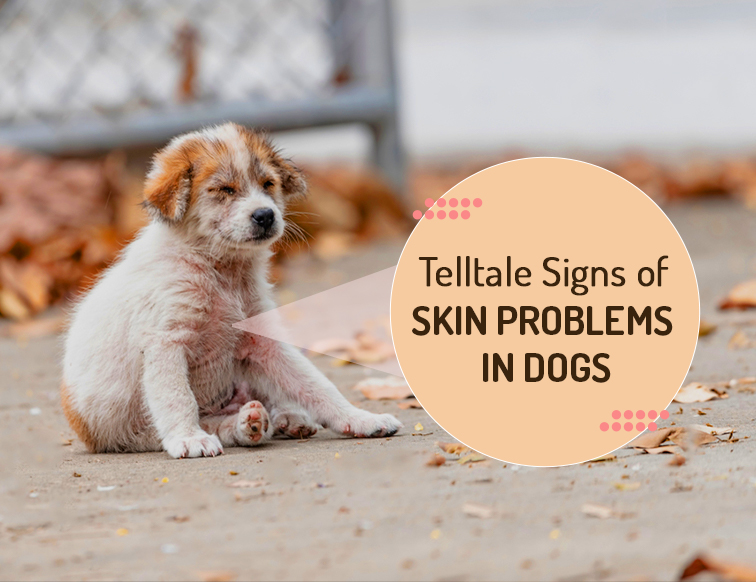Telltale Signs Of Skin Problems In Dogs

If your dog’s scratching and itching are giving you cause for concern, it’s time to look out for a skin infection. Dogs are very prone to skin infections, and it is the most common reason for them ending up at the veterinarian’s clinic.
Here are some obvious signs that your dog has a skin problem and what could be causing them:
#Rash
A rash (redness or irritation) can appear on any part of your dog’s skin, but it is quite common on the belly. These belly rashes may be due to several reasons, including insect bites, allergies due to lawn chemicals, fertilizers, poison ivy, etc.
If you suspect any skin infections, wash the affected skin to remove any of the irritants that may still be present. For contact dermatitis (allergic reactions due to contact), give your dog a cool bath using a good pet shampoo.
#Red bumps
Raised red bumps can be caused for several reasons. If the bumps are smaller and have crusts, they could be caused by folliculitis, which is a bacterial or fungal skin infection.
If they are larger and without crust, they may be caused by an allergen and are called hives. Your veterinarian will most likely prescribe antihistamines for hives.
#Red Spots
Red spots are generally caused by black fly bites. They appear suddenly in the belly area and usually do not bother the dog. Sometimes, these spots can be confused with the red spots of ringworm. However, ringworm spots can appear anywhere on the dog’s body and may irritate them.
[Also Look] How to Treat Skin Problems in Dogs?
#Scabs
Scabs occur as a result of crusting of the skin after a short-lived pustule (or pimple) pops and crusts over. Scabs on dogs may occur due to fleas, mites, or skin infections.
If it has happened due to ectoparasites like fleas and mites, a flea prevention treatment may help while in the case of skin infections, medicated shampoos and ointments work for relief.
#Skin Irritation
Episodes of skin irritations are common in dogs. The most efficient technique to cure irritated skin is to find the source of the allergic reaction, whether it’s to a meal, fleas, or something in their environment.
A gentle oatmeal dog shampoo or oatmeal bath can be used to soothe and moisturize the skin while the core problem is being investigated and to provide temporary comfort for your dog.
#Dry and Flaky Skin
More serious disorders like seborrhea, in which a dog generates too much sebum, or cheyletiellosis, which is caused by a mite and is also known as “walking dandruff,” can cause flaking of your dog’s skin.
These flakes, on the other hand, could just be an indication of dry skin. The first step in keeping your dog’s skin healthy is to feed them high-quality food that is high in omega-3 and omega-6 fatty acids.
Read: Simple And Easy Tips For The Skin Treatment Of Canine
#Itching
Allergies and external parasites such as fleas and mites are the two most common causes of itchy skin.
1. Allergic Reactions
Allergies frequently cause itching in a dog’s feet, armpits, flank, ears, and groin. A calming dog shampoo containing oats can be used to treat mild allergies or itching. Changing your dog’s diet to a sensitive-skin diet (rich in omega-3 and omega-6 fatty acids and commonly including fish as the major protein source) can also help.
2. External Parasites
Itching from fleas is most common around the base of the tail, on the stomach, and along the inner thighs. Itching caused by fleas and mites (which produce sarcoptic mange) must be treated with parasite-specific treatments, such as a flea preventative.
#Sores
Sores that don’t have a clear cause or aren’t healing properly could be an indication of a significant underlying problem like cancer or other disorders. These areas should be maintained clean while you consult your vet.
Bottom Line
Some of the above-mentioned dog skin disorders may be familiar to you, but we hope the others will help you better grasp the breadth of canine skin problems and identify the more evident symptoms that are often linked with each issue, as well as possible underlying causes. Check your dog for any of these symptoms on a regular basis, and take note of any reactions your dog has. It’s vital to take your dog to the veterinarian for a checkup if you detect any unusual behavior or skin issues.

